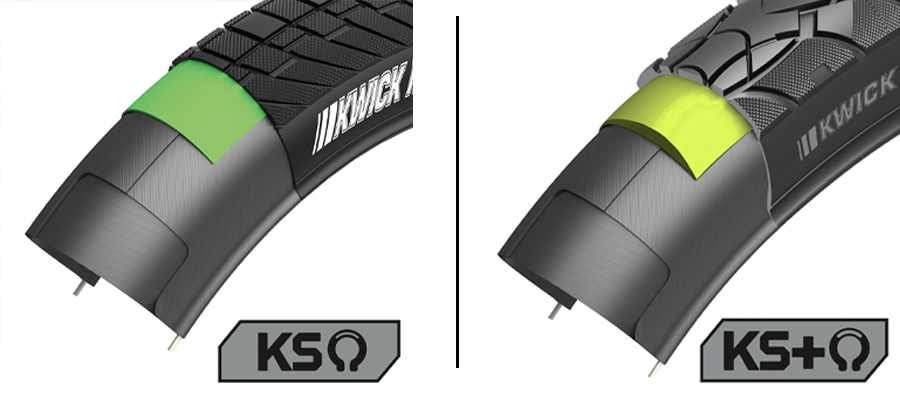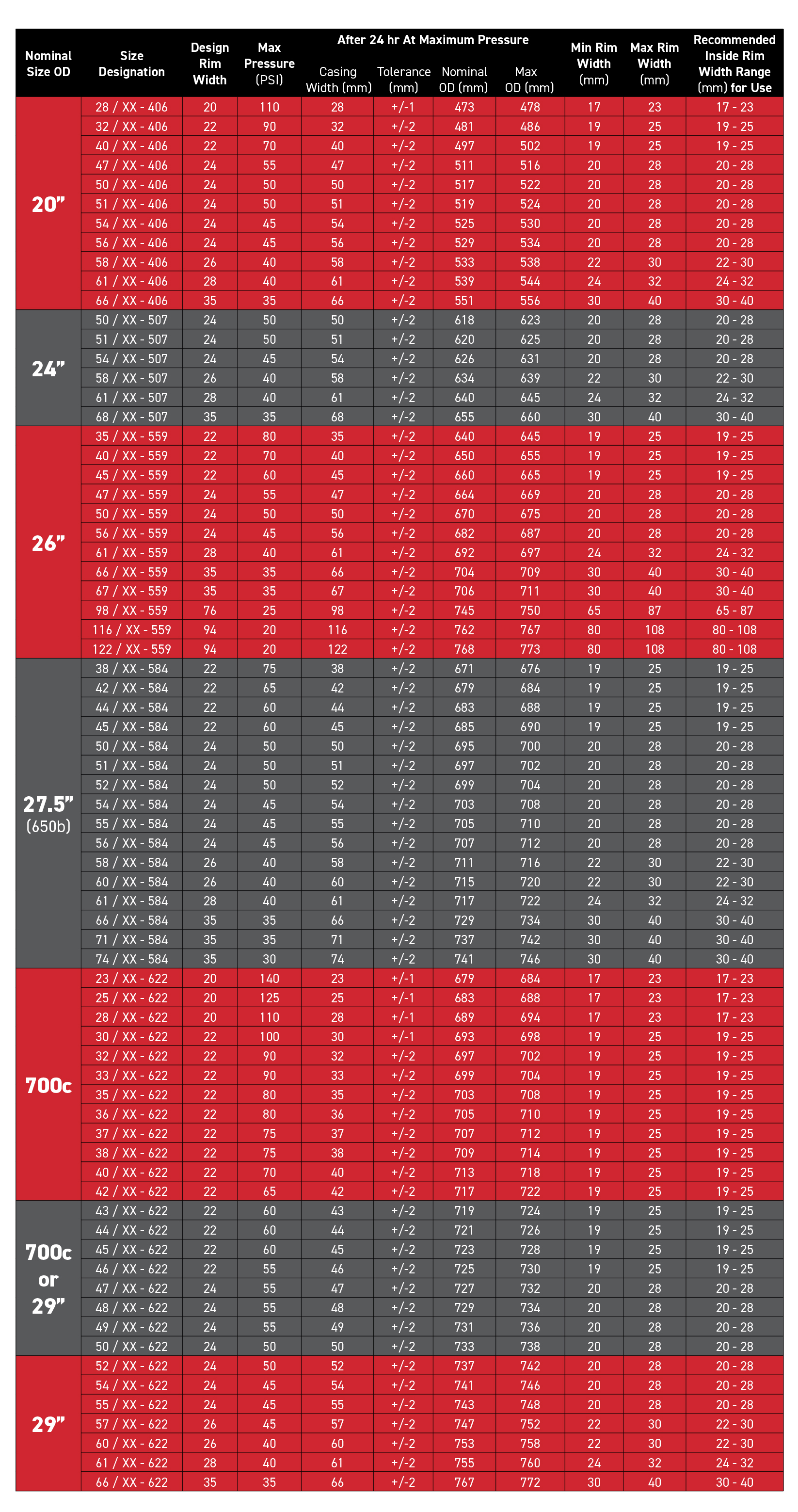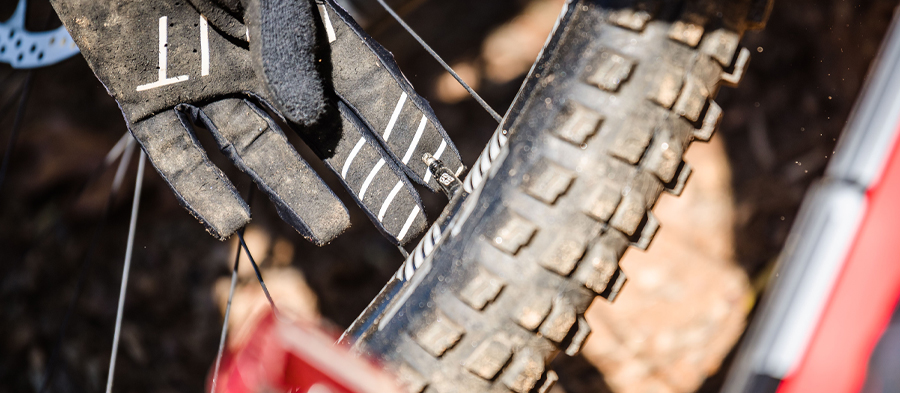| General FAQs |
 |
| Do tires stretch? |
| |
Tire
casing do stretch over time. Most of the
growth occurs with the first 24 hours of initial inflation, and of course the
higher the inflation pressure, the more rapid the stretch. Tire construction also plays a role; a 2-ply
DH tire will not grow the same amount as a tire with a single-ply 120 tpi
casing. When they are new, you can
install them and leave them inflated to maximum PSI labeled on the sidewall of
the tire for a few days to stretch them to max size, then air down to a reasonable
pressure before riding. |
| How often should I check my tire pressure? |
| |
It is good practice to check the pressure of your tires often. Air will slowly leak through the material of the tube / tires naturally and the pressure should be checked often to ensure the pressure is sufficient to not only prevent flat tires but also to ensure proper safety and performance. Higher pressure, lower volume tires such as road or gravel tires may need to be checked more often than lower pressure, higher volume tires like mountain bike or fat tires. We suggest checking the tire pressure weekly if not daily for some of the narrower higher pressure tires. |
| What is the difference between K-Shield and K-Shield Plus (KS+)? |
| |
Our K-Shield (KS) tire casing has a 3mm layer of light, flexible rubber containing aramid and ceramic particles under the tread area of the tire only. Designed to prevent punctures and increase tire life, this version is great for casual city/paved riding
For our K-Shield Plus (KS+) tire casing, we increased the thickness to 5mm to creat the best balance of puncture protection and great ride quality. This tire is great for going the extra mile.

|
| What is the white film on my tire? |
| |
Wax bloom is normal for bicycle tires and does not affect the tire's performance. It is found in a variety of compounds and protects the tires from ozone. It is purely cosmetic and can be removed with soap and water if desired.
.jpg)
|
| What is TPI? |
| |
Threads per inch
Tire casing is the fabric that the rubber compound adheres to. The fabric of the
casing can be made in varying thickness and threads per inch (TPI). Generally,
the higher the TPI number, the suppler the tire sidewall will feel and flex.
This means a more comfortable ride compared to that of a lower TPI casing. The
casings can be treated and reinforced with various materials in order to
achieve different degrees of puncture resistance and ride qualities. |
| What size tire do I need? |
| |
The ISO (International Organization for Standardization) has developed a universal tire and rim sizing system that help with determining the size of tire you need. Older English size (eg. 26x1-3/8) and French size (eg. 700x28c) tire dimensions are still used today but most bicycle tires are also marked according to ETRTO or European Tire and Rim Technical Organization (eg. 28-622)
The ISO system uses two sets of numbers to determine tire size. The first number indicates the width and the second indicates the inner diameter of the tire. The ETRTO size specification 28-622 would indicate a tire width of 28mm and the tire's inner diameter of 622mm. Both the ISO as well as either the English or French size will be listed on the sidewall on the hot patch or directly molded into the rubber of the tire. It is important to find the correct size in order to avoid the hassle of returns or exchanges.

|
| What tube should I order? |
| |
Step 1: Pick the Right Tube Size
You need to know two dimensions of the tube size, the diameter of your wheel/tire and the width of your tire. These dimensions can be found in both Standard English Sizing (example: 29x2.20) or ETRTO (example: 56-622) and can be found on the sidewall of your tire. Find the tube that has the same diameter as your tire/wheel and the tube that falls within the range of your tire. Tubes will stretch to fill the inside of the tire and therefore come in a width range (example: 29x2.00-2.40).
Step 2: Pick the Right Valve Stem
There are two main valve types, Presta and Schrader, and need to be chosen based on the wheel the tire/tube is being fitted to. Presta valves are longer and skinnier than the Schrader valve and are typically metal with threads and have a valve core that you unscrew to allow air in and out. Schrader valves are the larger valve that is more recognizable to most people due to them being "car air valves". Make sure to double check the tire and tube you require before purchasing to avoid having to return/exchange for the right tube or having a malfunction up installation.

|
| Why don’t I see my current tire on your website? |
| |
As you may have noticed, we do not have every single bicycle tire we
make available for purchase on our website. American Kenda Tire opened the B2C
website to start selling our premium tires directly to our customers. Since then,
we’ve decided to add more product such as sport models and sale items and will
potentially offer more options for you in the future!
A lot of replacements you see in bicycle shops will not be available on
the website because we sell the more common tires in bulk to distribution
warehouse who then sell to your local bicycle shop.
If a Kenda tire came
stock on your bicycle and you cannot find it in our online store or at your
local bicycle shop, it’s because we make this tire specifically to stock on bicycles
and sell directly from our manufacturing facility in Taiwan to the company that
build/ship those bicycles. Some of these OEM tires are not going to be stocked
in our warehouse. |


